1996 GMC SIERRA wheel torque
[x] Cancel search: wheel torquePage 78 of 404
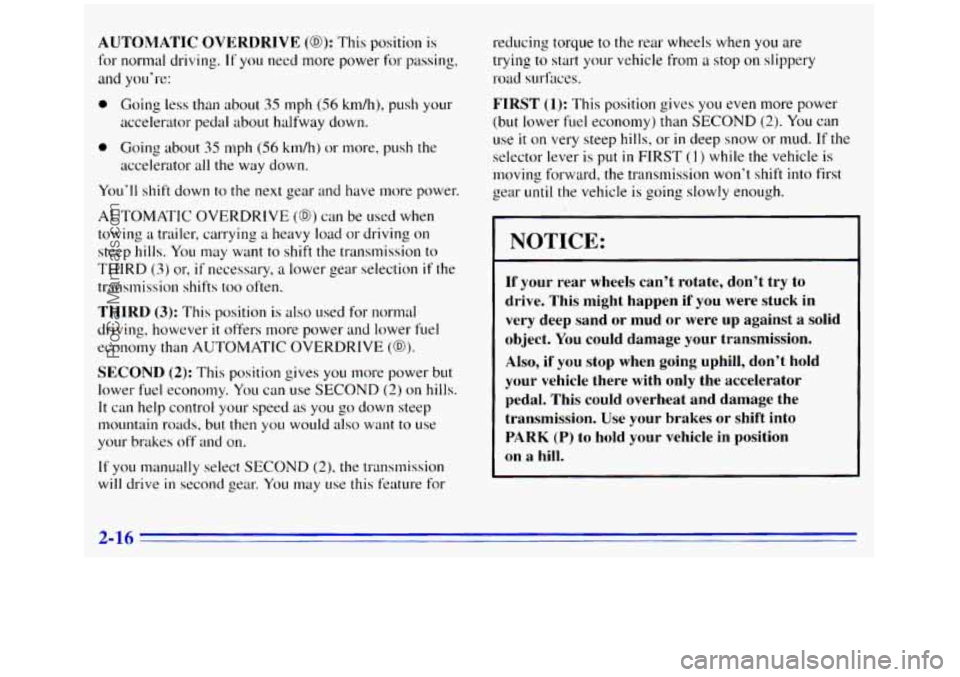
AUTOMATIC OVERDRIVE (0): This position is
for normal driving. If you need more power for passing,
and you’re:
0 Going less than about 35 mph (56 km/h), push your
accelerator pedal about halfway down.
accelerator all the way down.
0 Going about 35 mph (56 kdhj or more, push the
You’ll shift down to the next gear and have more power.
AUTOMATIC OVERDRIVE
(GO) can be used when
towing a trailer, carrying
a heavy load or driving on
steep hills. You may want to shift the transmission to
THIRD
(3) or, if necessary, a lower gear selection if the
transmission shifts
too often.
THIRD (3): This position is also used for normal
driving, however
it offers more power and lower fuel
economy than
AUTOMATIC OVERDRIVE (68).
SECOND (2): This position gives you more power but
lower fuel economy. You can use
SECOND (2) on hills.
It can help control your speed as you go down steep
mountain roads, but
then you would also want to use
your brakes off and on.
If you manually select SECOND (2), the transmission
will drive in second gear. You may use this feature for reducing torque to
the rear wheels when
you are
trying to start your vehicle
from a stop on slippery
road surfaces.
FIRST (1): This position gives you even more power
(but lower fuel economy) than
SECOND (2). You can
use it on very steep hills, or in deep snow or mud. If the
selector lever is put
in FIRST (1) while the vehicle is
moving forward, the transmission won’t shift into first
gear
until the vehicle is going slowly enough.
NOTICE:
If your rear wheels can’t rotate, don’t try to
drive. This might happen if you were stuck in
very deep sand or mud or were
up against a solid
object. You could damage your transmission.
Also, if you stop when going uphill, don’t hold
your vehicle there with only the accelerator pedal. This could overheat and damage the
transmission. Use your brakes
or shift into
PARK
(P) to hold your vehicle in position
on a hill.
2-16
ProCarManuals.com
Page 90 of 404
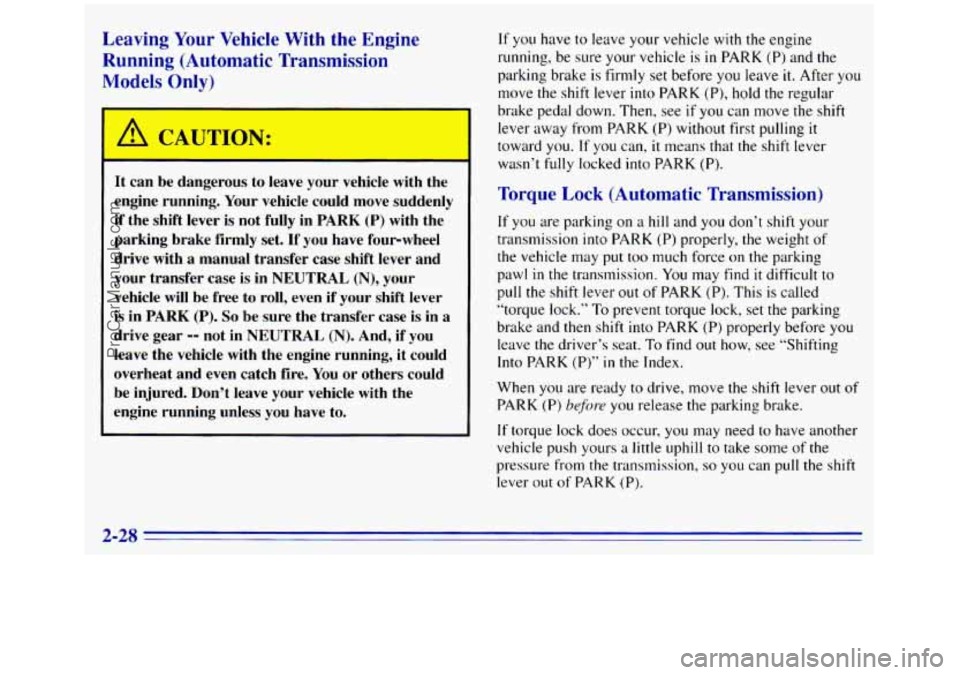
Leaving Your Vehicle With the Engine
Running (Automatic Transmission
Models Only)
I A ‘CAUTION:
It can be dangerous to leave your vehicle with the
engine running. Your vehicle could move suddenly
if the shift lever is not fully in PARK
(P) with the
parking brake firmly set.
If you have four-wheel
drive with
a manual transfer case shift lever and
your transfer case is in NEUTRAL
(N), your
vehicle will be free to roll, even if your shift lever
is in PARK (P). So be sure the transfer case is in a
drive gear
-- not in NEUTRAL (N). And, if you
leave the vehicle with the engine running, it could
overheat and even catch fire. You or others could
be injured. Don’t leave your vehicle with the
engine running unless you have to.
If you have to leave your vehicle with the engine
running, be sure your vehicle
is in PARK (P) and the
parking brake is firmly set before you leave
it. After you
move the shift lever into PARK (P), hold the regular
brake pedal down. Then, see
if you can move the shift
lever away from PARK (P) without first pulling
it
toward you. If you can, it means that the shift lever
wasn’t fully locked into PARK (P).
Torque Lock (Automatic Transmission)
If you are parking on a hill and you don’t shift your
transmission into PARK
(P) properly, the weight of
the vehicle may put too much force on the parking
pawl
in the transmission. You may find it difficult to
pull the shift lever out
of PARK (P). This is called
“torque lock.”
To prevent torque lock, set the parking
brake and then shift into PARK (P) properly before you
leave the driver’s seat.
To find out how, see “Shifting
Into PARK (P)” in the Index.
When
you are ready to drive, move the shift lever out of
PARK (P) before you release the parking brake.
If torque lock does occur, you may need to have another
vehicle push yours a little uphill to take some of the
pressure from the transmission,
so you can puIl the shift
lever out
of PARK (P).
2-28
ProCarManuals.com
Page 244 of 404
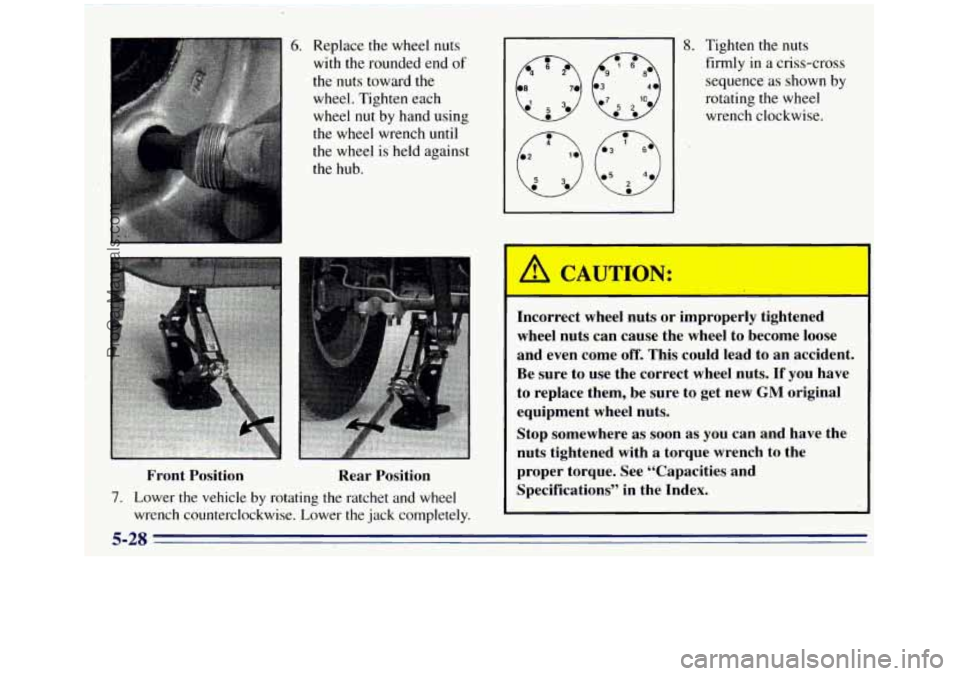
~~ Front Position
6. Replace
the wheel nuts
with
the rounded end of
the nuts toward the wheel. Tighten each
wheel
nut by hand using
the wheel. wrench until
the wheel is held against
the hub.
Rear Position
7. Lower the vehicle by rotating the ratchet and wheel
wrench counterclockwise. Lower the jack completely.
8. Tighten the nuts
firmly
in a criss-cross
sequence
as shown by
rotating the wheel
wrench clockwise.
Incorrect wheel nuts or improperly tightened
wheel nuts can cause the wheel to become loose
and even come
off. This could lead to an accident.
Be sure to use the correct wheel nuts.
If you have
to replace them, be sure to get new
GM original
equipment wheel nuts.
Stop somewhere as soon as you can and have the
nuts tightened with
a torque wrench to the
proper torque. See “Capacities and
Specifications” in the Index.
5-28
ProCarManuals.com
Page 245 of 404

NOTICE:
Improperly tightened wheel nuts can lead to
brake pulsation and rotor damage. To avoid
expensive brake repairs, evenly tighten the wheel
nuts in the proper sequence and to the proper
torque specification.
9. Put the wheel trim back on. For vehicles with plastic
wheel
nut caps, tighten the caps until they are finger
tight, then tighten them an additional one-half turn
with the ratchet and wheel wrench.
Storing a Flat or Spare Tire aqd Tools
Storing a jack, a tire or other equipment in the
passenger compartment
of the vehicle could
cause injury. In a sudden stop or collision, loose
equipment could strike someone. Store all these
in the proper place.
Store the flat tire where the spare tire was stored.
For an underbody spare tire carrier, stow
the tire under
the rear of the vehicle
in the spare tire carrier. To stow
the tire:
1.
2.
3.
4.
5.
Put the tire on the ground at the rear of the vehicle
with the valve stem pointed down and
to the rear.
Tilt
the retainer downward and through the wheel
opening. Make sure that the retainer is
fully seated
across the underside
of the wheel.
Attach the ratchet,
with the UP mark facing you,
near the hook at the end of the jack handle. Insert the
other end, on an angle, through the hole
in the rear
bumper and
into the hoist shaft.
Raise
the tire fully against the underslue 01 le
vehicle. Continue turning the ratchet
until mere are
two “clicks”
or “ratchets.” The spare tire hoist
cannot
be over-tightened.
Grasp and push against
the tire to be sure it is stored
securely and
does not move.
f 29
ProCarManuals.com
Page 286 of 404

NOTICE: .
Continuing to drive with worn-out brake pads
could result in costly brake repair.
Some driving conditions or climates may cause a brake
squeal when the brakes are first applied or lightly
applied. This does not mean something is wrong with
your brakes.
Free movement
of brake calipers and properly torqued
wheel nuts
are necessary to help prevent brake
pulsation. When tires
are rotated, inspect.brake calipers
for movement, brake pads for wear, and evenly torque
wheel nuts in the proper sequence
to GM specifications.
If you have rear drum brakes, they don’t have wear
indicators, but
if you ever hear a rear brake rubbing
noise, have the rear brake linings inspected.
Also, the
rear brake drums should be remoQed and inspected each
time the tires are removed for rotation or changing.
When you have the front brakes replaced, have the rear
brakes inspected,
too. I
Brake linings should always be replaced as complete
axle sets.
Brake Pedal Travel
See your dealer if the brake pedal does not return to
normal height, or if there is a rapid increase in pedal
travel. This could be a sign of brake trouble.
Brake Adjustment
Every time you make a brake stop, your disc brakes
adjust for wear.
If your brake pedal goes down farther than normal, your
rear drum brakes may need adjustment. Adjust them by
backing up and firmly applying the brakes a few times.
Replacing Brake System Parts
The braking system on a modern vehicle is complex. Its
many parts have to be
of top quality and work well
together if the vehicle is to have really good braking.
Vehicles we design and test have top-quality
GM brake
parts
in them, as your vehicle does when it is new. When
you replace parts of your braking system -- for example,
when- your brhke linings wear do.wn and you have
to
haye new ones put in -- be sure you get new genuine
GM replacement parts. If you don’t, your brakes may
no longer work properly. For example,
if someone
puts in brake linings that are wrong for your vehicle,
the balance between your front and rear brakes can
change
-- for the worse. The braking performance
you’ve come to expect can change
in many other ways
if someone puts in the wrong replacement brake parts.
I
I
6-36
ProCarManuals.com
Page 301 of 404
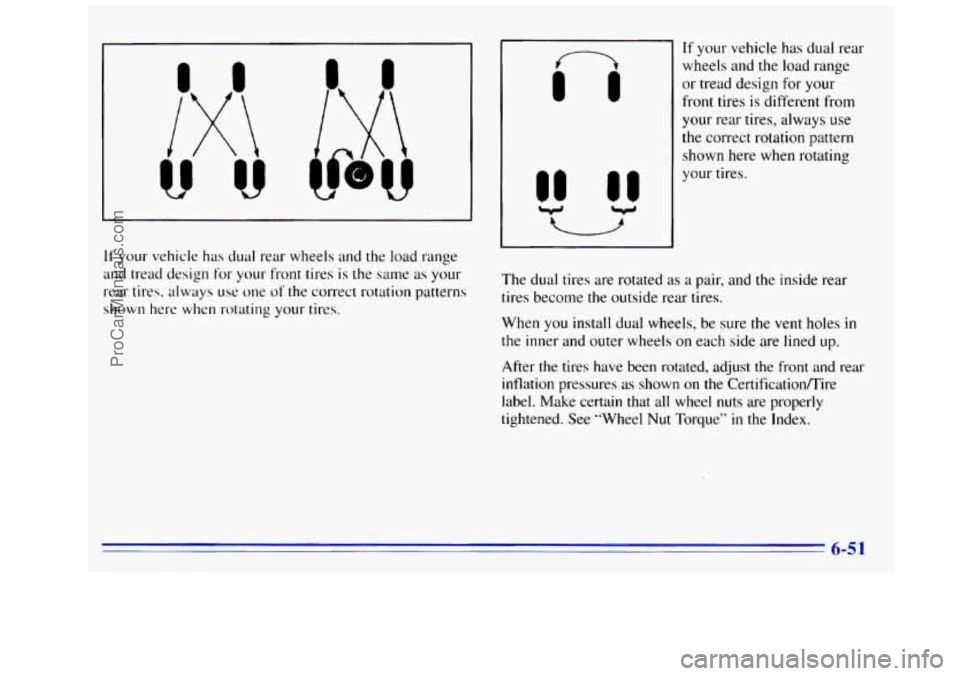
rTl
II
If your vehicle has dual rear wheels and the load range
and tread design for your front tires is the same as your
rear tires. always
use one of the correct rotation patterns
shown here when rotating your tires.
11 If your vehicle has dual rear
Q
wheels and the load range
or tread design for
your
~ front tires is different from
your rear tires, always use
the correct rotation pattern shown here when rotating
your tires.
The dual tires are rotated
as a pair, and the inside rear
tires become the outside rear tires.
When
you install dual wheels, be sure the vent holes in
the inner and outer wheels on each side are lined up.
After the tires have been rotated, adjust the front and rear
inflation pressures as shown on the Certificatiomire
label. Make certain that
all wheel nuts are properly
tightened. See “Wheel
Nut Torque” in the Index.
ProCarManuals.com
Page 303 of 404
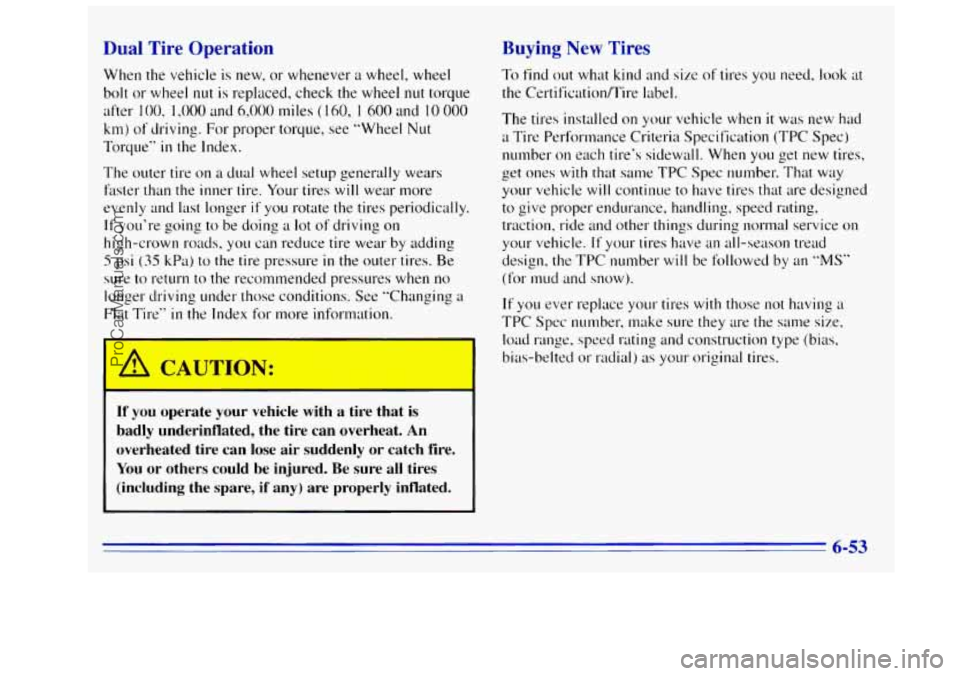
Dual Tire Operation
When the vehicle is new, or whenever a wheel, wheel
bolt or wheel nut is replaced, check the wheel nut torque
after
100, 1,000 and 6,000 miles ( 160, I 600 and IO 000
km) of driving. For proper torque, see "Wheel Nut
Torque" in the Index.
The outer tire on a dual wheel setup generally wears
faster than the inner tire. Your tires will wear more
evenly and last longer
if you rotate the tires periodically.
If you're going to be doing a lot of driving on
high-crown roads,
you can reduce tire wear by adding
5 psi (35 kPa) to the tire pressure in the outer tires. Be
sure to return to the recommended pressures when no
longer driving under those conditions. See "Changing
a
Flat Tire" in the Index for more information.
A CAUTION:
I
If you operate your vehicle with a tire that is
badly underinflated, the tire can overheat. An
overheated tire can lose air suddenly or catch fire.
You or others could be injured. Be sure
all tires
(including the spare, if any) are properly inflated.
Buying New Tires
To find out what kind and size of tires you need, look at
the Certificntion/Tire label.
Tlze tires installed
on your vehicle when it was new had
a Tire Performance Criteria Specification (TPC Spec)
number
on each tire's sidewall. When you get new tires,
get ones
with that same TPC Spec number. That way
your vehicle
will continue to have tires that are designed
to give proper endurance, handling, speed rating,
traction, ride and other things during normal service
on
your vehicle. If your tires have an all-season tread
design,
the TPC number will be followed by an "MS"
(for mud and snow).
If you ever replace your tires with those not having a
TPC
Spec number, make sure they are the same size,
load range, speed rating and construction type
(bias,
bias-belted or radial) as your original tires.
6-53
ProCarManuals.com
Page 306 of 404

Each new wheel should have the same load-carrying
capacity, diameter, width, offset and be mounted the same way as the one it replaces.
If you need to replace any
of your wheels, wheel bolts
or wheel nuts, replace them only with new
GM original
equipment parts. This way, you will be sure
to have the
right wheel, wheel bolts and wheel nuts for your vehicle.
CAUTION:
I
Using the wrong replacement wheels, wheel bolts
or wheel nuts on your vehicle can be dangerous.
It could affect the braking and handling of your
vehicle, make your tires lose air and make you
lose. control.
You could have a collision in which
you or others could be injured. Always use the
correct wheel, wheel bolts and wheel nuts for
replacement.
NOTICE:
The wrong wheel can also cause problems with
bearing life, brake cooling, speedometer or
odometer calibration, headlamp aim, bumper
height, vehicle ground clearance and tire or tire
chain clearance to the body and chassis.
7
Whenever a wheel, wheel bolt or wheel nut is replaced
on a dual wheel setup, check the wheel
nut torque after
100,
1,000 and 6,000 miles (160, 1 600 and 10 000 km)
of driving. For proper torque, see “Wheel Nut Torque”
in
the Index.
See “Changing a Flat Tire” in the Index for
more information.
6-56
ProCarManuals.com